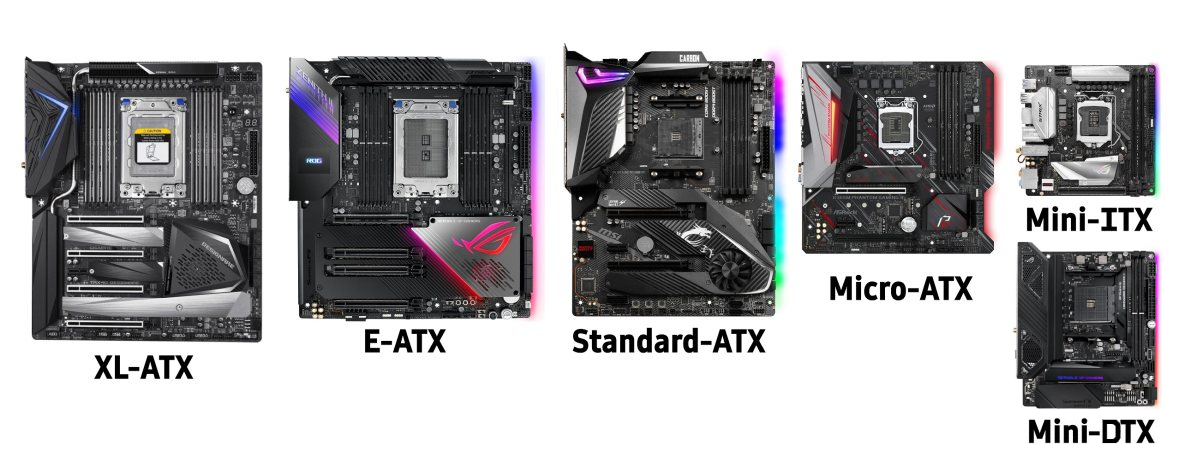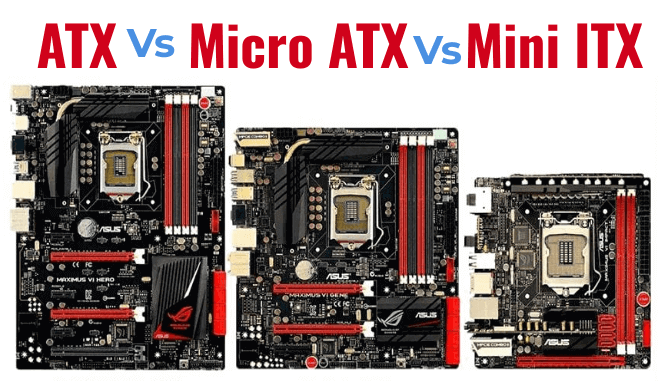ATX Vs Micro ATX Vs Mini ITX – Which You Should Choose?

Choosing the right motherboard for your computer can be daunting, given the plethora of options one has to negotiate. Understanding the differences between ATX, Micro ATX, and Mini ITX can facilitate this selection process. Your choice of a motherboard is instrumental in determining several key variables. These include the size of your build, expandability options, and your system’s performance, cost, and compatibility.
A motherboard’s form factor not only dictates the physical dimensions of the board but indirectly influences other critical factors. The form factor you choose impacts the size and type of case you will use, the CPU, cooler, RAM capacity, number of graphics card slots, storage options, and the power supply you can install.
For gaming enthusiasts, the form factor will affect the system’s overclocking capabilities, which are necessary for unleashing the full potential of their machine. Meanwhile, those seeking a workstation for rendering, editing, or streaming tasks must consider a form factor that can accommodate the superior processing power and memory capacity these tasks typically require.
Simultaneously, users keen on portability would be wise to consider smaller form factors more conducive to compact builds. However, smaller systems often grapple with noise, heat, and airflow issues, so a proper balance must be struck. The chosen form factor will also impact cable management, thus affecting the system’s aesthetics.
Ultimately, the choice between ATX, Micro ATX, and Mini ITX depends on your budget, needs, and preferences. It’s essential to understand the components you need, their compatibility with different form factors, the balance you want to strike between size and performance, and the trade-offs involved. Knowledge of these contributing factors will guide you in making the best choice for your unique requirements.
What is a Motherboard?
A motherboard is essentially the lifeblood of a computer system. It is a robust, rectangular circuit board communicating with and connecting all the significant components like the CPU, RAM, graphics card, and storage devices. Selecting a motherboard dramatically conditions the capabilities and capacity of your computer.

Components of a Motherboard
The crucial components of any motherboard encompass the CPU socket that houses the processor, alongside memory slots for accommodating RAM. You’ll also find expansion slots for adding hardware like graphics cards.
The chipset manages the dialogue between the CPU, RAM, and other components, while power connectors liaison with the power supply. Finally, multiple input/output (I/O) ports are available for connecting peripheral devices.
Different Motherboard Form Factors
Motherboards come in distinct form factors – the ATX, Micro ATX, and Mini ITX – each affecting various aspects such as the size of the motherboard, its expandability, performance, and relative cost. The form factor also outlines the type of case a system can use and its spatial layout.
Functions of a Motherboard
The motherboard’s principal functions include moderating communication, power, and control among the system’s components. The chipset oversees data conveyance between the CPU, RAM, storage, and peripherals, with the power connectors facilitating energy distribution.
Why is the Motherboard Important?
Understanding the crucial importance of the motherboard is key. It governs the type of CPU the system can incorporate, the amount of memory it can support, the kind, and quantity of expansion slots, and the species of storage installable.
It has a profound impact on a system’s functionality, influencing its performance for gaming, overclocking, use as a workstation, or abilities for rendering, editing, and streaming tasks. Consequently, your needs, preferences, and budget should direct your motherboard choice, as this dictates components’ compatibility, the balance in your system’s attributes, and potential trade-offs. In summary, a well-chosen motherboard clears the path toward a best-choice system tailored for you.
What is a Form Factor?

A form factor refers to the physical specifications of a certain component within a computer system. When it comes to a motherboard, for example, the term form factor is used to define its physical size, the type of case it fits into, the motherboard’s layout, the power supply unit it requires, and its mounting holes.
The form factor is crucial when it comes to building your computer, as it dictates what type of case you’ll need, how many expansion slots you’ll have available for things like video or sound cards, types of ports like USB Ports, Audio Ports, HDMI Port, and DisplayPort, and even how efficient the system’s cooling mechanisms will be.
In the context of this article, we are focusing on the three most common motherboard form factors: ATX, Micro ATX, and Mini ITX, each of which has its unique advantages and disadvantages in terms of size, cost, performance, compatibility, and use case.
Why is the Form Factor of a Motherboard Important?
Determining your motherboard’s form factor is crucial—it dictates what type of case you’ll need, the amount of PCI Express (PCIe) slots, SATA ports, and M.2 slots for storage, and compatibility with particular CPUs and GPUs, among others. The availability of USB ports, Ethernet ports, audio ports, and display ports, all depend on the motherboard you choose.
Overview of Atx, Micro Atx and Mini Itx Motherboards

Atx Motherboards
Advantages
ATX motherboards offer plentiful expansion slots for add-ons like sound and network cards. These motherboards also come with more SATA ports and PCI slots, ideal for high-end systems where you may wish to use multiple GPUs or other expansion cards. High performance and overclocking utility make this type an excellent choice for gaming PCs and workstations.
Disadvantages
The downside to ATX motherboards is their size, taking up more space inside the computer case, resulting in less portability. ATX motherboards are also typically more expensive compared to their smaller counterparts.
Best Use Cases
ATX motherboards are best suited to high-performance workstations, gaming PCs, or any use case where extra expansion slots are necessary and size is not a significant concern.
Micro ATX Motherboards
Advantages
Micro ATX motherboards are smaller than their ATX siblings, allowing for more compact and portable case designs. They still retain a reasonable number of expansion slots and offer exceptional value for money. The compact size does not compromise the performance capability, making it a go-to choice for gaming and workstation performance.
Disadvantages
The Micro ATX form factor might not provide sufficient expansion slots for users who want to run multiple GPUs or other expansion cards. The size of the motherboard can also limit the overall cooling ability of the system.
Best Use Cases
Micro ATX motherboards are suitable for users seeking a balance between performance, size, and cost, making it a preferred choice for budget and mid-range gaming PCs.
Mini Itx Motherboards
Advantages
The Mini ITX motherboard is the smallest form factor among these three options, offering excellent potential for portability and small form factor (SFF) PCs. Despite its small size, it still offers stability and satisfactory performance for daily use, gaming, and media center tasks. The small form factor also favors portability case weight reduction.
Disadvantages
Due to the size constraint, the Mini ITX form factor only has a single PCIe slot and fewer RAM slots and storage ports. Its smaller size can also impact cooling performance, and it generally costs more due to the premium for miniaturization.
Best Use Cases
Mini ITX motherboards are well suited for small form factor (SFF) PCs, home theater PCs (HTPCs), and other compact, portable configurations.
Comparison Table
| ATX | Micro ATX | Mini ITX | |
| Size | Largest | Medium | Smallest |
| Expansion Slots | Most | Moderate | Least |
| RAM Slots | Most (Typically 4-8) | Moderate (Typically 4) | Least (Typically 2) |
| SATA/M.2 Ports | Most | Moderate | Least |
| Price | Generally Higher | Generally Lower | Variable, can be high |
| Performance | High | High | Possibly Limited due to less expansion |
| Cooling | Easiest due to larger size | Sufficient | More challenging due to compact size |
| Compatibility | High (due to more slots and size) | High | Limited due to size |
| Best Use Case | Gaming PC, Workstation | Budget, Mid-range PCs, Compact Gaming PC | Small Form Factor PC, Home Theater PC |
Which Form Factor Should You Choose?
Factors to Consider
When selecting a motherboard form factor, consider your use case, available budget, desired performance, cooling ability, compatibility, and portability requirements. Are you building a high-end gaming system, a powerful workstation, a budget-friendly desktop, or a compact home theater PC?
Recommendations
A full-sized ATX motherboard should be your top pick for the best performance and overclocking stability improvement. Provided you have ample space and a larger budget, ATX boards offer the most expandability, cooling fan noise reduction, and are ideal for high-performance, high-end PCs.
If you are on a budget, want a smaller footprint with solid performance, and need modest expansion capabilities, a Micro ATX motherboard is a great choice. It offers a good balance between cost and component compatibility chart, ideal for a budget to mid-range or gaming PC.
If portability or space is a more significant concern than expandability, the Mini ITX motherboard is the way to go. Despite their small size, they can pack a punch with proper component selection, ideal for small form factor PCs (SFFPCs) or home theater PCs (HTPCs).
Frequently Ask Questions
1. What is a Form Factor?
Form factor refers to a motherboard’s physical specifications such as its size, shape, and arrangement of components—like the CPU Socket or PCI Express Slots. It determines the motherboard’s compatibility with a computer case and the number of expansion slots available.
2. Can I Use an Atx Case for a Micro Atx or Mini Itx Motherboard?
Yes, ATX cases are usually designed to accommodate all three types of motherboards. The ATX case would have additional stand-offs supporting smaller motherboards. However, choosing a case matching your motherboard size is suggested for aesthetic and space-saving purposes.
3. Does Form Factor Affect Performance?
Indirectly, yes. While the form factor itself doesn’t impact the performance, the Motherboard Layout, Cooling, and hardware components supported by the motherboard due to its size can affect system performance. For example, ATX motherboards can house more RAM and GPUs, providing better performance than a comparable Micro ATX or Mini ITX motherboard.
4. Which Form Factor is Best for Gaming?
ATX, Micro ATX, and Mini ITX can be suitable for gaming depending on specific needs. If you need maximum performance, overclocking capabilities, and multiple expansions (like several GPUs), an ATX motherboard is preferable. A Mini ITX can be a good choice for small form factor gaming builds, while Micro ATX balances size, performance, and cost.
5. Does a Smaller Motherboard Mean Less Power?
Not necessarily. A smaller motherboard like a Mini ITX can still house powerful CPUs and GPUs. But it might offer less room for updates later due to fewer expansion slots.
6. Why Are Mini Itx Motherboards Expensive?
Despite their small size, Mini ITX motherboards can be expensive due to the high costs of manufacturing compact and efficient designs. This includes advanced engineering, layout optimizations, and potentially higher-quality components that can withstand closer quarters and potential heat issues.
Conclusion:
Your choice between an ATX, Micro ATX, and a Mini ITX motherboard will fundamentally shape your computer’s size, performance, expandability, and cost.
Each of these form factors presents unique advantages and potential trade-offs, accentuating different aspects of your system, be it gaming, overclocking, portability, or workstation capabilities.
Careful consideration of your budgetary constraints, individual needs, and component compatibility is crucial in making an informed choice.
The ultimate goal is achieving a well-balanced system that optimally caters to your specific usage and aesthetic preferences.




